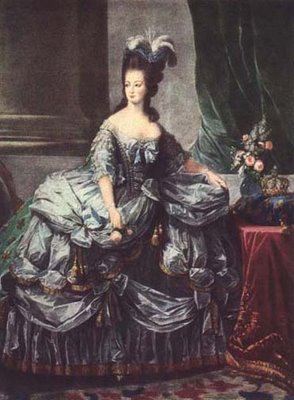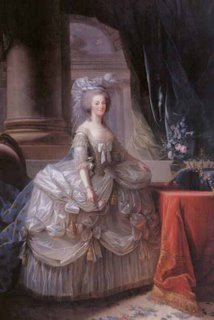Fall Vogue Rising


Is something unusual happening in Paris or is this really about somehing new happening at American Vogue? The editorial pages of this year's customary encyclopaedic
September issue are suddenly swirling with truly spectacular high style, after many, many years. Buried in a plethora of edgy fall
 advertising one discovers Anna Wintour's best editorial writing in a long time, a beautiful piece that puts her at the forefront of notable chroniclers of a swiftly changing world.
advertising one discovers Anna Wintour's best editorial writing in a long time, a beautiful piece that puts her at the forefront of notable chroniclers of a swiftly changing world.The Spanish Riding School
 I confess, my first reaction to Kirsten Dunst on the cover and the tribute to Sofia Coppola's brilliant rock movie was, Oh, good, a little fantasy for a change, but that's just a costume! And a counterfeit Jeffrey "Joseph" Jones in my head scanned the layout and sniffed, "too many fonts!" Then I saw that between Grace Coddington and Annie Leibovitz, they had made it easy to see that the dress on the cover and the other dresses Milena Canonero designed for the movie are distinctly modern --as much attuned to contemporary tastes as the retroussé noses and chiselled chins in the pictures. Here are distillations rather than imitations of the 18th Century pannier hoop dresses so often on view at The Met from The Costume Institute. In fact, the dresses especially made by Rochas, Oscar de la Renta, Chanel Haute Couture, Alexander McQueen, DiorCouture/John Galliano, and Balenciaga/Nicolas Ghesquière for Vogue and Kirsten Dunst in the Teen Queen spread all show what a very long way the technologies of substance, heft, cut and drape have come since Rose Bertin kicked things off. What an interesting idea, too, to bankrupt other people by example-- if that is indeed what Marie Antoinette did, I hope nobody will lose their shirt trying to live like Michael Chow.
I confess, my first reaction to Kirsten Dunst on the cover and the tribute to Sofia Coppola's brilliant rock movie was, Oh, good, a little fantasy for a change, but that's just a costume! And a counterfeit Jeffrey "Joseph" Jones in my head scanned the layout and sniffed, "too many fonts!" Then I saw that between Grace Coddington and Annie Leibovitz, they had made it easy to see that the dress on the cover and the other dresses Milena Canonero designed for the movie are distinctly modern --as much attuned to contemporary tastes as the retroussé noses and chiselled chins in the pictures. Here are distillations rather than imitations of the 18th Century pannier hoop dresses so often on view at The Met from The Costume Institute. In fact, the dresses especially made by Rochas, Oscar de la Renta, Chanel Haute Couture, Alexander McQueen, DiorCouture/John Galliano, and Balenciaga/Nicolas Ghesquière for Vogue and Kirsten Dunst in the Teen Queen spread all show what a very long way the technologies of substance, heft, cut and drape have come since Rose Bertin kicked things off. What an interesting idea, too, to bankrupt other people by example-- if that is indeed what Marie Antoinette did, I hope nobody will lose their shirt trying to live like Michael Chow. Supposedly, Rose Bertin said, "There is nothing new except what is forgotten." But that is not quite right. Things advance. Of course, the new shapes and proportions have an ancestry within a single
Supposedly, Rose Bertin said, "There is nothing new except what is forgotten." But that is not quite right. Things advance. Of course, the new shapes and proportions have an ancestry within a single generation of living
generation of living memory. Now, two amd a half inches of excess hair shorn off the Kawakubo-Rykiel
memory. Now, two amd a half inches of excess hair shorn off the Kawakubo-Rykiel bob, and rendered anew in the color of lacquered cherrywood
bob, and rendered anew in the color of lacquered cherrywood tops off the longest equine neck ever seen. Here are the proportions of leg and dress launched in 1967 as cartoons, in the sense of preliminary sketches, by Pierre Cardin and Rudi Gernrich. This time, in 2006, the other idiomatic shape of wide legged trousers and tiny jackets reveal an expertise and flowing confidence and precision of proportion impossible to achieve the last time around. Still, the new developments bear a strong link to 1967-68, the last time the world spun into heady dissent and outright revolution.
tops off the longest equine neck ever seen. Here are the proportions of leg and dress launched in 1967 as cartoons, in the sense of preliminary sketches, by Pierre Cardin and Rudi Gernrich. This time, in 2006, the other idiomatic shape of wide legged trousers and tiny jackets reveal an expertise and flowing confidence and precision of proportion impossible to achieve the last time around. Still, the new developments bear a strong link to 1967-68, the last time the world spun into heady dissent and outright revolution.Perhaps without irony, amid all the renewed celebration of the art of high fashion and taste, Daphne Beal's article about new fortunes made and new enterprises managed by good looking young women in India focuses on the emergence of India's recently consumer-oriented economy, and the social dynamics of mass production and mass communication. (Despite the sour little remark from the understandably baffled and "recently departed" Elizabeth Bumiller, quite a few Americans now in their prime and living in the U.S. have always known that India matters.) The markets for processed food and recorded entertainment and cars are hardly new to India, although foreign investment is growing by leaps and production is diversifying fast. One thing that is brand new, though, is the rising confidence of city dwellers in the reincarnated art of developing new forms of Indian dress. Now, with Tao Kurihara's new take on unstitched clothes taking the stage over here, is this not the moment to get rid of petticoats under saris? That clunky practice was originally adopted in the 1870's by Indian rajkumaris and zamindarnis, to jibe with the nadir of style then dictated by that other Germanic princess, the widowed Queen Victoria, the very antithesis of Marie Antoinette and her court.

Much that is presented in this issue is elevated and unified by the variety of veiled or masked faces, whether it's that netting, fine as mist or chunky as a catcher's face guard, or Takahashi's sinister hoods, or the painterly use of makeup-- all creating the fascination of mystery and distance, just as the therapist recommends.
A note of thanks for the end page's closing affirmation about "the synchronicity bewteen high fashion and hgh art." People are gong to keep this one on tables, then on bookshelves and eventually for years in their attics.
Portraits of Marie Antoinette by Elisabeth Vigée-Lebrun are all over the Internet.....





